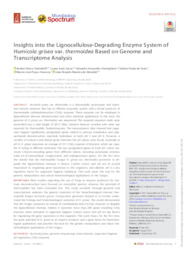Insights into the Lignocellulose-Degrading Enzyme System of Humicola grisea var. thermoidea Based on Genome and Transcriptome Analysis.
Insights into the Lignocellulose-Degrading Enzyme System of Humicola grisea var. thermoidea Based on Genome and Transcriptome Analysis.
Autoria: STEINDORFF, A. S.; SERRA, L. A.; FORMIGHIERI, E. F.; FARIA, F. P. de; POÇAS-FONSECA, M. J.; ALMEIDA, J. R. M. de
Resumo: Abstract: Humicola grisea var. thermoidea is a thermophilic ascomycete and important enzyme producer that has an efficient enzymatic system with a broad spectrum of thermostable carbohydrate-active (CAZy) enzymes. These enzymes can be employed in lignocellulose biomass deconstruction and other industrial applications. In this work, the genome of H. grisea var. thermoidea was sequenced. The acquired sequence reads were assembled into a total length of 28.75 Mbp. Genome features correlate with what was expected for thermophilic Sordariomycetes. The transcriptomic data showed that sugar-cane bagasse significantly upregulated genes related to primary metabolism and polysaccharide deconstruction, especially hydrolases, at both pH 5 and pH 8. However, a number of exclusive and shared genes between the pH values were found, especially at pH 8. H. grisea expresses an average of 211 CAZy enzymes (CAZymes), which are capable of acting in different substrates. The top upregulated genes at both pH values represent CAZyme-encoding genes from different classes, including acetylxylan esterase, endo-1,4-b-mannosidase, exoglucanase, and endoglucanase genes. For the first time, the arsenal that the thermophilic fungus H. grisea var. thermoidea possesses to degrade the lignocellulosic biomass is shown. Carbon source and pH are of pivotal importance in regulating gene expression in this organism, and alkaline pH is a key regulatory factor for sugarcane bagasse hydrolysis. This work paves the way for the genetic manipulation and robust biotechnological applications of this fungus.
Ano de publicação: 2021
Tipo de publicação: Artigo de periódico
Unidade: Embrapa Agroenergia
Palavras-chave: Bagaço, CAZy enzymes, Cana de Açúcar, Genome, Genome sequencing, Humicola, Humicola grisea, PH regulation, Sugarcane bagasse, Transcriptome, Variação Genética
Observações
1 - Por padrão são exibidas publicações dos últimos 20 anos. Para encontrar publicações mais antigas, configure o filtro ano de publicação, colocando o ano a partir do qual você deseja encontrar publicações. O filtro está na coluna da esquerda na busca acima.
2 - Para ler algumas publicações da Embrapa (apenas as que estão em formato ePub), é necessário ter, no celular ou computador, um desses softwares gratuitos. Sistemas Android: Google Play Livros; IOS: iBooks; Windows e Linux: software Calibre.
Acesse outras publicações
Acesse a Base de Dados da Pesquisa Agropecuária (BDPA) para consultar o acervo completo das bibliotecas da Embrapa.

